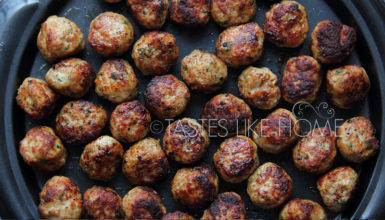Hi Everyone,

There are recipes I adapt when cooking for myself and there are recipes I adapt for publication such as this column, my blog, or an international audience. These are very different audiences, and while a recipe is adapted, it is always done in a manner that mostly maintains the integrity of the dish as it relates to taste and texture.
Ingredients
The availability and access to certain ingredients is one of the main reasons for adapting a recipe. One must take into consideration what is in one’s pantry, what one is willing to splurge on and what is readily available in one’s geographical location. For example, the recipe for the Turkish Pide recommended ground lamb, while lamb may be readily available in many markets, the meat may not be sold in a ground/minced form, or if it is, it may be pricey and not cost effective, therefore, adapting by using ground beef is a very good alternative. Not everyone has high-grade olive oil in his or her pantry; adapting using vegetable oil does not take away from the dish. Another reason for adapting a recipe by ingredient may be one of dietary reasons. Hindus would prefer to use lamb instead of beef or someone staying away from red meat might opt for ground chicken.
Equipment
Recipes are developed and tested on certain heating devices such as stoves, oven and grills (charcoal, gas, wood). The method of heat conducted may vary – gas, electric, wood, coals, indoors, outdoors. To make naan, not many of us have clay-burning tandoors that will quickly cook the dough and give it that signature smoky char.
Cooking times and temperatures would vary too depending on the medium used to cook; therefore in adapting recipes, one must test them (recipes) using the equipment one has in one’s home. These days, cooktops and ovens come with different types of energy levels, such as induction (cooktops) and convection (ovens). Induction and convection equipment heat up quicker and finish cooking faster. Going back to the adaption of the Kiymali Pide, in the directions, I suggested switching the pans halfway through baking for even cooking. The reason for this is that most of us have conventional ovens – when heated the hot air hangs in the oven and bakes evenly when everything is on one shelf, however, when we stack the shelves with pans, the heat gets diverted, in some ovens most of it goes to the top and in others it goes to the bottom. Therefore, by switching the pans halfway through cooking, the food cooks evenly at the same time. In a convection oven, it would not be necessary to switch the pans because that type of oven comes with a fan built it at the back that evenly circulates the heat around the oven.
Tools

By tools I mean things such as pots, pans, spoons, ladles etc. and can include things like rolling pins, mortar and pestle and small appliances. An original recipe might have been created to feed 6 – 8 people but you are only cooking for 2 – 4 people, or vice versa. The size of the pot/pan used would have to be adapted, as would the quantity of ingredients required to cook the dish. Many bread and cake recipes these days are written with a home cook that has a stand mixer in mind. It would indicate the hook to be used, the speed at which to mix and the duration. Someone (like myself) who does not have a stand mixer has to adapt the kneading or mixing time if using a small hand mixer, or simply mixing/kneading by hand. The duration of time that the dough or batter would need to be folded, kneaded or mixed would be longer when working by hand.
A recipe might specifically call for a cast iron pan that can start the cooking process on the stovetop and then migrate to the oven. However, not everyone has a cast iron pan or a similar type of pan that can be transferred directly from the stovetop to the oven, therefore, in testing and adapting a recipe, one would have to suggest a way to start the cooking on the stove top and then transfer it to another pan to finish cooking. I might suggest cooking from start to finish in the oven at a particular temperature other than that suggested in the original recipe. Or, it might be that the same dish can be adapted to cook on the stovetop covered, or uncovered at a recommended heat gauge.
Quantites/portions
From personal experience I can tell you that I have shied away from making certain things because the recipes are to feed at least 6 people and require large quantities of ingredients that can only be used for 1 purpose. While it is easy to cook and share with my tasters, I also know that there are certain things that they are unwilling to try and would not try, so I retreat.
Last week’s Turkish Pide recipe makes 2 large pides and while I made both the first time I tried the recipe, I have since scaled the recipe so that I only make one. With the scaled recipe, I cut the dough in half so that I make 2 smaller pides, one vegetarian and one with meat.
The bottom line here is that we adapt recipes – scaling up or down depending on how many people we are cooking for.
Your personal touch

Finally, another reason to adapt a recipe is to put your personal touch, your own cooking sense, technique, and your ‘hand’ so to speak to the dish. One of the easiest examples of this is when a recipe indicates salt and pepper to taste. In this way, a recipe is adapted to suit your personal preference. For example, you may like more cheese in your macaroni pie, you may like your fish fried deep brown, and you may like your sugar cake soft, your fudge not fully set or lots of black pepper in your pone.
This is where you take a recipe and make it your own by the way in which you prepare it. Another example is this – give 5 people with the same level of cooking skill the same ingredients and ask them to make the same dish, you will see how different in look, flavour and texture the dish would be. That’s because they each employed their own cooking skill and technique to create the dish.
The next time you find a recipe, don’t be afraid to adapt it, even if it is already adapted.
Cynthia





